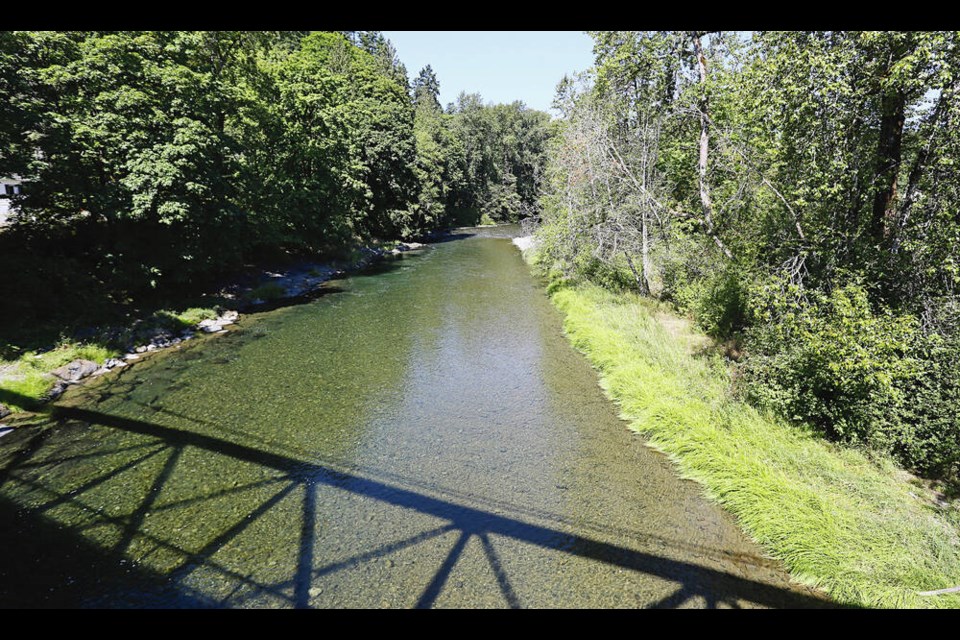The Sept. 1 fishing opening on the Cowichan River should be cancelled because the river is in a “catastrophic” state due to a perfect storm of factors such as high-water temperatures and drought, say advocates.
A 6.4-kilometre “dead zone” has formed in the upper part of the river, said Joe Saysell, 75, who has lived on the river all his life. “It’s the worst thing that’s ever happened in my 75 years of living here on the river.”
The situation highlights the need for a new weir (a barrier regulating heights of a river), said Saysell, of the Friends of the Cowichan organization. “We’ve got to start getting this weir raised right now.”
A proposed weir design, drawn up for a public advisory group, would raise the elevation by 70 centimetres above the existing weir, built about half a century ago to store water for the Crofton mill, now owned by Paper Excellence.
Paper Excellence is again planning to bring in pumps to pull water out of Cowichan Lake and send it into the river until fall rains arrive. It has set up pumps several times in the past decade.
The Cowichan’s decline “is the death of 1,000 cuts,” Saysell said.
He points to May’s hot temperatures and ongoing blue skies resulting in little water entering Lake Cowichan. He fears algae in the water and sunscreen from recreational users on a low river might have combined to damage the Cowichan River.
Alarms were raised when swimmers found dead fry in July. Saysell figures that “thousands upon thousands” of fry died. It’s impossible to know how many because scavengers clean up carcasses immediately, he said.
Saysell said dead brown and rainbow trout of up to 55 centimetres (close to 22 inches) have also been found.
“We’ve lost so many of our big spawning trout from the river,” he said. “I can’t believe it. It is just so heartbreaking.”
Some surviving large fish are blind and are bumping into rocks, he said. Their eyes have turned white. “It’s horrible, horrible, horrible.”
No live fry have been found in the 6.4-kilometre dead zone, he said.
–°¿∂ ”∆µ’s Forests Ministry, responsible for fishing openings on the Cowichan, said in a Monday statement: “The Ministry is closely monitoring the situation and will not hesitate to bring in closure orders, with our partners from DFO (Fisheries and Oceans Canada), should they become necessary — as we did last week in the Okanagan.”
Testing has come back showing mortality within normal ranges, the ministry said.
The province and federal fisheries have installed monitoring stations which are being checked regularly, it said.
“The total number of dead fish are uncertain at this time but the abundance of fry of all species is believed to be significantly reduced in the mid-river region,” the Forests Ministry and federal fisheries said.
The types of fish killed were mainly salmonids — Coho salmon fry, rainbow trout and steelhead in the fry and parr (fish that have spent one year in water) stages and brown trout in all life stages, they said.
Factors that could have contributed to the deaths include low dissolved oxygen in the water and high pH related to algae growth mid-river, and high temperatures and low flow, they said.
Saysell is worried that underground cold-water streams that feed the river will dry up in the heat.
The river appears healthier further downstream below Stoltz pool to Duncan, Saysell said.
The province should at least order a 6.4-kilometre stretch on the upper river closed to fishing between September and March, after the salmon have spawned and fry hatched, he said.
Climate change impacts are becoming more severe and Saysell wonders what will happen in 2024. “Each time it happens, you knock off more of those big breeding fish. And before long, after two or three years, you’re not going to have any fish.”
Another concern is the impact on spawning beds when anchors are dragged by boats carrying anglers.
Graham Kissack, vice-president of environment, health and safety and communications for Paper Excellence, said a working group representing local interests is involved in managing the day to day flows on the river. “Once again we find ourselves in a drought situation which is causing a very significant water deficit.”
Modelling indicates that by early September there will likely not be enough water stored in the lake to run through the weir. “Zero water storage translates into essentially reducing the flows of water over the weir into the river and the river starts to run dry.”
The proposed higher weir would allow for better management of the river from spring through fall at an optimal rate, he said.
Former federal fisheries minister David Anderson said he supports Saysell, saying Saysell knows the most about the river. “I would side with Joe on this without hesitation.”
Pat George, president of the Haig-Brown Fly Fishing Association, said the Cowichan “still has some beautiful fish coming through but it is just a matter of a few more years and it is just going to crash. It’s just going to a wasteland.”
For information on the weir proposal: cowichanlakeweir.ca/weir-design
>>> To comment on this article, write a letter to the editor: [email protected]




